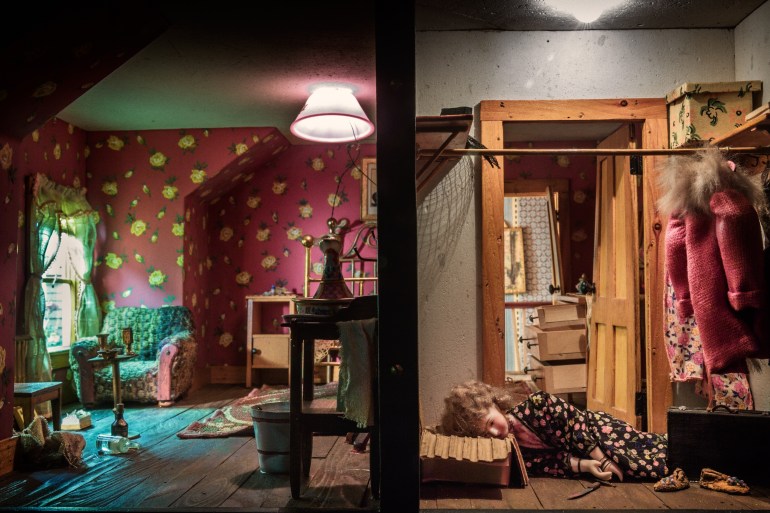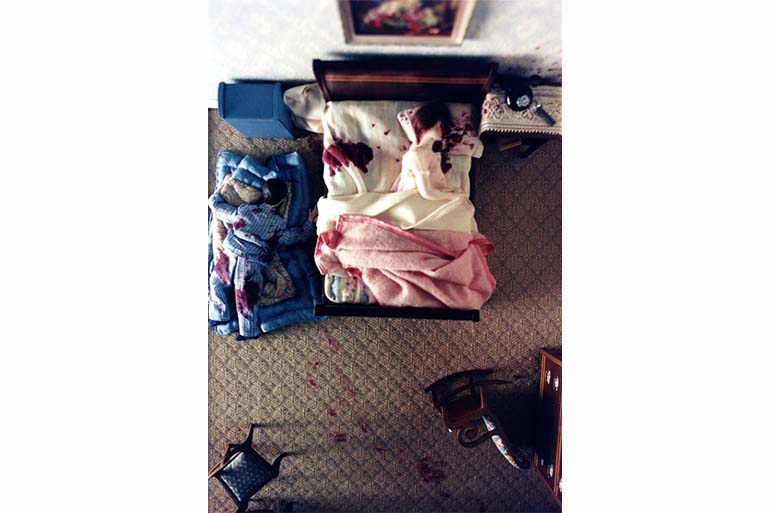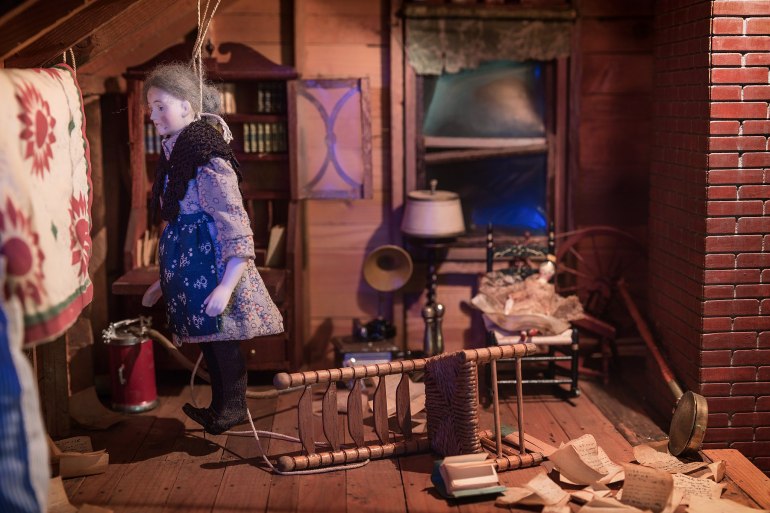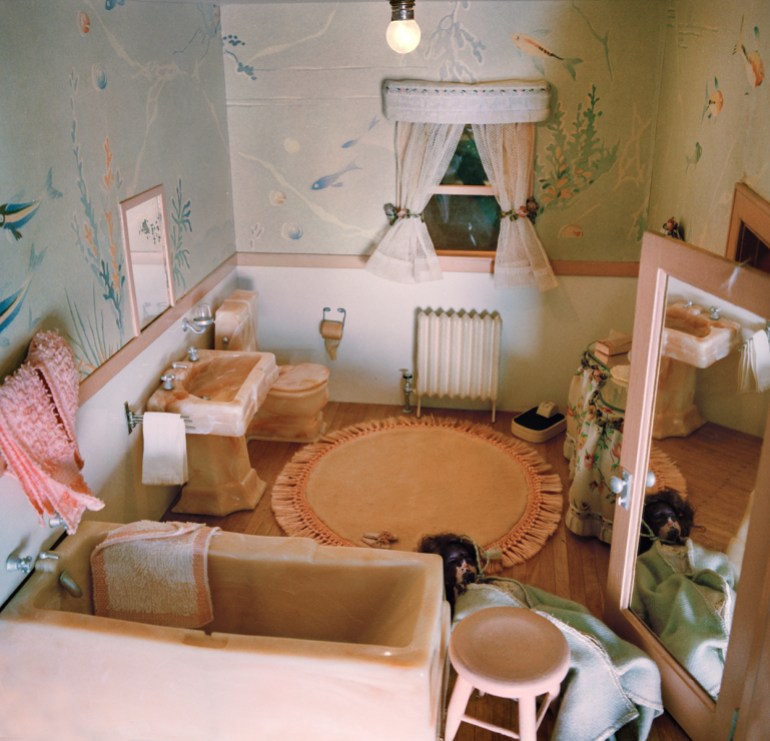The tiny murder scenes of forensic scientist Frances Glessner Lee
Lee was a diorama-maker, criminal investigation educator and the first female police captain in the US.

Listen to this story:
A husband and wife, lying in their bedroom, their baby in her crib in the adjacent nursery. A typical family on a typical morning, minus the red bloodstains on the beige bedroom carpet and the pink and white striped wallpaper behind the crib. All three family members, mother, father and baby, have been shot to death.
Keep reading
list of 4 itemsWoman, seeking loan, wheels corpse into Brazilian bank
Venezuela and Honduras announce actions to protest Ecuador’s embassy raid
International support for Tunisia’s jailed opposition leader Ghannouchi
While the scene may sound like something straight out of a true-crime show, it is a diorama called “Three-Room Dwelling” that was built in about 1944 by a 60-something Chicago heiress named Frances Glessner Lee.
It was made to train police officers in the handling and processing of evidence. The blood behind the baby’s crib allows officers to study blood spatter patterns.
Lee crafted her macabre dollhouse-sized crime scenes using miniatures, then considered a feminine craft, to educate in a field dominated by men.
In the 1940s and 1950s, when Lee created what came to be known as The Nutshell Studies of Unexplained Death, her dioramas were seen as a revolutionary and unique way to study crime scene investigation.
“There are a lot of things that aren’t visible to the casual observer,” says Bruce Goldfarb, executive assistant to the chief medical examiner for the state of Maryland and author of the 2020 book, 18 Tiny Deaths: The Untold Story of Frances Glessner Lee and the Invention of Modern Forensics.
In Lee’s dioramas, pencils can be used to write, light bulbs work, blinds can be lowered and raised, and jars are labelled. Lee was obsessive, according to Goldfarb, who is also her official biographer, a quality that could account for the level of detail and accuracy in her Nutshells. Lee even painted figures’ skin discolouration in shades to show the manner of death, including carbon monoxide poisoning and any signs of violence or lividity. Money was no issue and the dioramas could cost what a house at the time might, with each reaching well “into the thousands”, according to Goldfarb.
The process of miniaturisation was expensive. Lee had tiny newspapers printed and hired artists to paint miniature paintings. Tiny tools were created and for a hand mixer in one scene, she bought an expensive gold charm used for a bracelet.
Lee’s Nutshells were part of her push for a more scientific approach to investigating sudden or suspicious deaths, and her pioneering efforts to advance legal medicine, a field within forensic science that applies medical knowledge to crime-solving.
These pursuits came later in life. Lee, who was largely self-taught, is often called the “mother” of forensic science and was in her fifties when she discovered her true calling.

The would-be medical student
Frances Glessner was born in 1878 in Chicago, Illinois into a wealthy family. Her father owned part of a company that manufactured farming and construction equipment while her mother was a skilled silversmith. Lee and her older brother were educated with tutors in the family home, today an historic landmark, a mansion with 13 bedrooms, seven staircases, and 11 fireplaces.
Lee, known by friends and family as Fanny, was a clever and precocious child who learned how to sew and knit alongside her academic studies.
Her brother would attend Harvard University to study law while Lee would ignore her own interest in medicine because, according to Goldfarb, “It was Harvard or nothing.” Harvard Medical School did not admit women until the autumn of 1945. Even so, Lee would one day find a way to infiltrate the university.
Instead of attending college, Lee spent more than a year in 1896 and 1897 travelling in Europe, then married lawyer Blewett Lee in 1898. They had three children, John, Frances and Martha before divorcing in 1914.
In 1929, Lee, then 51, and her friend, George Burgess Magrath, the Suffolk County, Massachusetts medical examiner, and a leading legal medicine expert, spent time together recuperating at a hospital in Boston after undergoing medical treatments.
Magrath regaled Lee with stories about his job investigating deaths. He had played a major role in well-known criminal cases, and with his knowledge of ballistics, helped obtain a conviction against two Italian-American anarchists in 1921 after they killed two people during a botched bank heist.
Lee was moved by Magrath’s tales and his commitment to the work of medical examiners, who take autopsy findings from a crime scene and the laboratory to establish the cause of death. He believed medical examiners should be trained, and instituted and authored papers criticising the prevailing coroner system where an elected official, not a legal or medically trained expert, carries out an investigation.

The spark
While recuperating, it was an “offhand remark” that flipped a switch for Lee, Goldfarb says.
Magrath apparently said that the organs of the human body were so beautiful that they should be considered a work of art. Lee, who was able to see an autopsy performed by Magrath, saw how the arrangement of human organs could reveal the cause of death and saw beauty in that. Inspired to know more about legal medicine, she began to research on her own, collecting rare books on the subject and started learning from medical examiners and police investigators whom she befriended.
Magrath, for his part, studied legal medicine in Europe because there was nowhere to study it in the United States, something that Lee said “greatly surprised” her. “There was nowhere to go for the special training required by these [relevant] groups,” wrote Lee in a 1952 article for The Journal of Criminal Law and Criminology.
Magrath had told her how investigations would get botched and the incorrect cause of death listed due to a lack of training among police officers and coroners. He argued that this was the rule rather than the exception. These issues, along with the politics inherent in the coroner system, he believed, often meant those who committed crimes walked free and those who did not were convicted.
Through her studies, Lee became convinced of the need for better-trained experts and that every individual with an unexplained death deserved a fair and thorough investigation.

An ‘in’ for Lee
As a woman, Lee could not study at Harvard Medical School, but, having in recent years been left a significant inheritance she could offer the institution something important: money. And so she set about feeding her growing interest by funding research and teaching.
In the early 1930s, Lee persuaded Harvard University to let her endow her friend Magrath as chair of a new branch of study: legal medicine. That was the start of what developed into a fully fledged Department of Legal Medicine at Harvard Medical School.
Allowing for Magrath’s professorship and the promise of a new department meant Lee’s funding would continue in the future. “They both exploited each other. She wanted Harvard for the prestige,” Goldfarb says.
Lee contributed a library of manuscripts including rare books on poisoning, toxicology and the subject of criminology, and then in the mid-1930s gave the university a gift of $250,000 (today, about $5m). The department became active in 1938, the same year that Magrath, Lee’s mentor, and friend, died.
The department, now with a new head, aimed to research the causes of unexplained death for “the interests of science and justice”, Lee wrote in the 1952 article.
“A chief objective,” she wrote, “is to correlate the work of the public prosecutor, the medical investigator, and the law enforcement officer so that each may find his investigation easier, more efficient, and more accurate in its results.”
Lee finally got her “in” at Harvard.

Campaigning
Lee had also been inspired by the work Magrath had done to abolish the coroner system in New York City.
Botched investigations had driven reform of the city’s coroner’s office. In one such case, a man had been found dead in a hotel with a gunshot wound to the head. The coroner’s physician ruled the death a suicide and the body was cremated without an autopsy.
Cases like these prompted Magrath, who saw the coroner system as “an anachronistic institution”, to fight for its abolishment by testifying in the state legislature. In 1915, a law was passed to establish a medical examiner’s office allowing for an examiner to conduct autopsies in cases of unnatural or suspicious deaths independently of the police or district attorney. Three years later, New York City’s coroner system was abolished.
In the early 1930s, as the legal medicine department was forming, Lee, who was known for her determination and tenacity, took to campaigning for the medical examiner system. She would hit the road with her driver to speak at women’s social clubs and groups about the merits of science-based death investigations. She lobbied elected officials, influential doctors and the head of the FBI, and reached out to the public through exhibits at the Chicago World’s Fair of 1933-34.
Artist Corinne Botz, whose book The Nutshell Studies of Unexplained Death is based on a seven-year photography and research project that also featured an art exhibition of Botz’s photographs of the dioramas, says pushing for the medical examiner system was one of “Lee’s central aims”, with several states adopting it in her lifetime.
Today, 14 states operate on a county, district or parish-based coroner system, 14 have both systems while 16 have a centralised medical examiner office and six have a county or district-based office.
But to do better death investigations, detectives needed to secure crime scenes properly for medical examiners. “Cops moved evidence around, walked through blood, put their fingers in bullet holes,” says Goldfarb.
Lee believed that police investigators, as the first to arrive on a crime scene, needed training to understand how to handle evidence to best solve a crime.
In New Hampshire where she had a summer cottage, she had gotten to know the state police colonel, a political connection of her brother, and several officers. She even had a police radio – possibly a gift from the colonel – set up in her home whose frequency often left her listening to dispatches not only in New Hampshire but also in the state of Virginia.
Lee started to mull over the idea of creating a short seminar for investigators who could go to Harvard’s legal medicine department and learn from the many legal medicine experts there.
In the late 1930s or early 1940s, she started holding one or two-day training sessions at Harvard, in her New Hampshire home – where she had moved full-time for the fresh air by 1941 – or at the state police headquarters.
In 1943, at 66 years of age, Lee’s friend, the police colonel, who shared her vision for training, appointed her educational director for the New Hampshire State Police and a police captain for the force – the first woman in the US to hold such a post. According to Goldfarb, she was invested with all the police power to enforce the state’s criminal laws and could make arrests, although she never did, focusing instead on training and advocacy.

A sought-after seminar
In 1945, Lee held the first of her five-day seminars at Harvard and provided training in the emerging field of forensics starting mostly with New Hampshire police.
Police officers were invited by Lee, herself. “During her travels visiting various police departments, Lee kept notes on potential students,” writes Goldfarb in his book. “She looked for police officers who were bright, had attended college, and were early enough in their career to take full use of the specialized training.”
Lee’s longtime friend Erle Stanley Gardner, who wrote the Perry Mason series of mystery books, said in the foreword of one of his books that invitations to the seminar became, “as sought after in police circles as bids to Hollywood by girls who aspire to be actresses”.
No more than two students from one organisation were allowed to attend. Initially open only to men, in 1949, at Lee’s insistence, women were included.
Lee wrote that every effort was made “to provide the police students with the most modern and progressive scientific training possible … The old days are gone – the days when ‘brogue and brawn’ were the requisites to make a city foot-policeman, and today the policeman is an educated, well-trained gentleman.”
Among the key tools she used to train investigators in crime scene analysis were the dioramas. Lee, who had in her 30s made a miniature Chicago Symphony Orchestra as a gift for her mother, some 30 years later harnessed her talent as a miniaturist to make at least 20 Nutshells. Approximately 11 were finished between 1943 and 1945 by the time she began the seminar.

Tiny death scenes
The purpose of the Nutshells was simple. They were meant to train officers to “convict the guilty, clear the innocent, and find the truth in a nutshell,” as the police adage goes.
“An effort has been made to illustrate not only the death that occurred but the social and financial status of those involved, as well as their frame of mind at the time the death took place. Not all cases shown are crimes – some are accidents, some are deaths due to natural causes – some, because of inexpert or careless investigation, remain undetermined,” wrote Lee.
She reflected this careless investigation, through, for example, one diorama made up of two living rooms that are nearly identical which Goldfarb describes in his book. One side shows a man who was shot to death and is sprawled on the floor. The right side “shows conditions after a helpful trooper moved the victim to the couch. The trooper is standing, taking notes, while the wife sweeps up the debris of china broken when her husband collapsed.”
The dioramas are composites. Lee pulled from real cases, and her own research, and added her own autobiographical and personal touches. In one diorama, she used a portrait above a tiny mantle to display her own cottage. “Lee took a lot of artistic licence – she had fun – while making them,” Botz says.
“The crime scene models are a rich amalgam of the period in which Lee lived, the crimes that captured her attention, her autobiography, biases, and idiosyncrasies. I love the interplay between real/fact and imaginary/fiction in the models,” she says.
Botz, who calls them “visual masterpieces”, is struck by the contrasts: “The nostalgic and cosy interiors combined with death and destruction.”
The Nutshells depict domestic middle-class interiors or those such as boarding houses occupied by more marginalised people in society.
In one a farmer hangs from a noose in a hay-filled barn. In another, a woman is dead on the floor of a kitchen, an open oven revealing a baked cake.
Lee worked alongside a carpenter, Ralph Moser, who built interiors including doors, windows, woodwork and floors, while she assembled the dolls and clothes and many other precise details – like the corpse dolls’ face colouring to reflect the level of decomposition – featured in the dioramas.
Lee’s devotion to accuracy also applies to the details of the crime, including the placement of bloodstains and spatter.
The dioramas, “became an incredibly innovative way to teach police investigators to pay attention to tiny details and potential forensic evidence that can lead them to solve the case,” says Dr Erin N Bush, assistant professor of US and digital history at the University of North Georgia.
For the seminar attendees analysing the dioramas, Lee provided notes laying out certain aspects of the cases for each Nutshell and gave them approximately 90 minutes to study the scene. Investigators used a geometric search pattern – Lee often suggested observing in a clockwise contracting spiral – applied to crime scenes to ensure no evidence was missed.
Lee wrote that she created these dioramas as, “an exercise in observing, interpreting, evaluating and reporting”.
Clues and details include a lipstick mark found under a pillow, a wall with a bullet, an overturned ashtray, ligature marks painted on the dolls’ necks, half-peeled potatoes near a sink, and old letters at the foot of a body. “The Saloon and Jail” features graffiti written in pencil on the wall.
Solutions to the miniature crime scenes do exist, though they are held under lock and key, according to Goldfarb; solving the crimes was not really the point. “The point was to use them to learn to train your eye to see minute, seemingly insignificant details,” says Bush. “As a culture, we’re obsessed with ‘whodunits,’ but these are much more than just little mysteries,” she says, referring to the dioramas’ value as educational tools.

‘Mother’ Lee
Lee, who was a grandmother by the time she ran the seminars, and “wore brimless Queen Mary hats and black dresses she sewed herself,” according to Goldfarb’s book, was respected by the homicide investigators she nurtured.
“The policemen were very much in awe of her and conceptualised her as a mother figure,” says Botz.
Her friend, Erle Stanley Gardner, in an obituary in the “Boston Globe” following Lee’s death in 1962, wrote that her “great big human heart” endeared her to the investigators she helped to train. “She came to regard the men in law enforcement as her ‘boys’ and they, in turn, gave her a respect and affection,” he wrote.
“The investigators called her ‘Mother’ Lee when she ran these events. She made the dioramas, but also organised the dinners and the receptions and basically ‘mothered’ these boys in blue,” says Bush.
The investigators observed a real autopsy conducted by a medical examiner on the second day – an exercise that is still part of the curriculum – and that night were treated by Lee to a fancy dinner. She made sure they left with a diploma of completion and sent them cards and food at Christmas.
Today, the mostly annual seminar continues on-site at the Office of Chief Medical Examiner (OCME) in Baltimore, Maryland, where Goldfarb works and is called the Frances Glessner Lee Homicide Seminar. The course explores all elements of a forensic investigation including sharp force and blunt force injuries, strangulation, drowning, and blood-spatter patterns.
It is no longer affiliated with Harvard University. The seminar is hosted by HAPS (Harvard Associates in Police Science), a private nonprofit organisation founded in 1945 by Lee. In 1967, the Department of Legal Medicine closed, and Russell Fisher, a former research fellow who was the medical examiner at the OCME, and someone Lee knew and respected, took over the seminar. Thus, the Nutshells found their new and forever home.
Goldfarb says the seminar today remains remarkably similar to when Lee started it, although classes have been added according to newer technologies like DNA identification.
These days, anyone can attend. The annual five-day seminar plays host to homicide detectives, murder mystery authors, prosecutors, private investigators, and local and state police as well as FBI agents, according to Goldfarb.
Attendees come from all over the world, and it is the longest-running seminar of its kind. Eighteen dioramas remain at the OCME and are still studied.

Legacy
As a woman, Lee broke many barriers in a male-dominated field. For Botz, she was an early figure in the women’s movement with the Nutshells’ depiction of women’s isolation in the home and their exposure to “the violence that originates and is enacted there”.
In the 18 dioramas at the OCME, which mostly show rooms or areas of the home, there are 12 female victims. “It is also notable that the models depict a gendered notion of space and the majority of victims are women who have suffered violent deaths in the home. The models are a reminder that domestic space can be terrifying as well as safe,” says Botz.
“[Lee] subverted gendered categories in some ways, but then she also wholly embraced them in others,” by being a key figure in a field that was primarily made up of men, but also being a mother figure to many, says Bush.
She sees Lee’s legacy as rooted in being an educator. “She isn’t always described that way, but the Nutshells are incredibly innovative in how she used something so simple to educate,” Bush says.
“The Nutshell Studies gave Lee a voice in the world,” says Botz. It is one that continues to be heard, even 55 years after Lee’s death. Her voice lives on through the HAPS seminar and her dioramas which captured how the tranquil domesticity of middle-class America can hide a dark side – and is still studied in miniature.